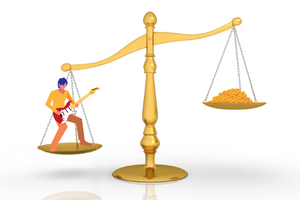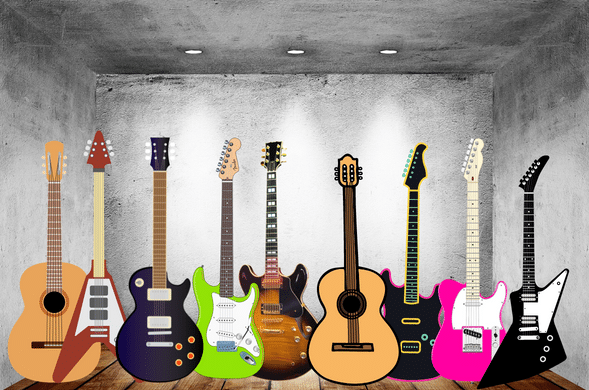Have you ever wondered why guitarists change guitars between songs? In this article, I’ll reveal the main reasons as well as the pros and cons of doing so. You might be surprised at some of the reasons why it’s better to have more than one guitar in your playing arsenal!
You can use the table of contents below to take you to the area that interests you. Click on the little box to open it, and then click on the section of the article you want to read, or you can read from start to finish if you want the full educational experience!
The Short Answer
The main reasons guitarists change instruments between songs are to switch to an alternate tuning, get a particular guitar sound onstage or in the recording studio, because of an unforeseen problem such as a broken string, and for the guitar’s “cool factor.”
Keep On Reading (Below) To Learn More
Pros And Cons Of Having Multiple Guitars


Here are some pros and cons of playing multiple guitars for fun or professionally.
| Pros | Cons |
|---|---|
| All guitars sound different | Additional guitars are expensive |
| Guitars can play differently | Guitars can be damaged in transit |
| Having guitars with unique tunings | May need a guitar tech |
| Backup guitar in case other one breaks | Multiple guitars increase chance of equipment failure |
| Can have six and seven-string guitars | Too many guitar changes may annoy your audience |
| Better for use in recording studio | |
| Adds “cool factor” to playing |
Keep On Reading (Below) To Learn More About Each Topic
Not All Guitars Sound The Same!
As I stated above, various guitars can sound remarkably different! If you’ve ever gone into a music store looking to buy a Strat, Tele, or whatever, you know how different they can sound.
Even if you play the same type of guitar, like three Fender Stratocasters, they might all have different body and neck tonewoods, pickups, and hardware. Any design difference or even string type and gauge can affect the sound.
Single-coil pickups have a thinner, sharper sound, while humbucking pickups have a thicker sound with more midrange and bass.
Thicker solid-body guitars can have more sustain than thinner ones.
Also, as a guitar ages, it can sound different, for better or worse. Some vintage guitars are coveted for their sound and cost a fortune, like a ’54 Strat, a ’59 Les Paul, and a Martin D-45 acoustic.
Why Guitars Play Different

Just like guitars can sound different, they can also have unique playing characteristics.
Playing an acoustic guitar is a great way to toughen your fingers by building calluses. You might be amazed at how easy it is to play your electric guitar after playing acoustic for a couple of weeks!
Here are some of the things that affect the way a guitar plays. Generally speaking, an electric guitar is easier to play than an acoustic instrument.
| Comparison | Electric Guitar | Acoustic Guitar |
|---|---|---|
| String Gauge | Lighter | Heavier |
| Action (String Height) | Lower | Higher |
| Body Cutaway(s) | Deeper | Shallower |
| Neck | Thinner | Thicker |
| Frets | Small to Jumbo | Medium |
- Lighter gauge (thinner) strings are easier to press down and bend than heavier ones.
- The lower the action, the easier the guitar generally is to play.
- Electric guitar cutaways give better access to higher frets than acoustic instruments.
- Thinner necks are easier to play on unless you have really big hands.
- Taller (jumbo) frets are easier to bend strings on
Recording Issues And Considerations
Some guitars just sound better than others in the recording studio. For example, for two guitars of the same type and similar design, one may sound better during recording playback.
I have two standard Teles that were made the same year and have the same tonewoods, neck shape, and electronics, but one has more of an overall “presence” during a recording playback. It’s a subtle but important difference.
Single-coil pickups record differently than humbucker or piezoelectric pickups. Guitars with noiseless pickups can remove hum and other noise from the recording.
Professional players usually go into the recording studio with several guitars to get the sound they’re looking for on each song and to safeguard against instrument problems.
Slide Guitar Can Be Problematic
Depending on the style of slide guitar you play, you may require a unique guitar setup.
For example, some players use special tunings when they play slide, like open G. This tuning brings the E strings down a whole step (to D), so the guitar is tuned to a G chord (D G D G B D).
Also, some slide players prefer a much higher action, so there is less fret buzz, and it’s easier to use the guitar slide.
Having another guitar setup to play slide can save you from re-tuning a guitar or struggling with higher action when playing without the slide. Some players have more than one slide guitar setup in various tunings.
Alternate And Drop Tunings
Tuning changes can be time-consuming, depending on the particular tuning and the guitar that is being used.
Alternate Tunings
Common alternate tunings can be played on any guitar with a standard gauge string set. However, it’s still time-consuming to retune the guitar between songs during a gig.
DAD GAD tuning (D-A-D-G-A-D) is a favorite among acoustic fingerpicking guitarists.
For electric players, half-step down tuning (Eb-Ab-Db-Gb-Bb-Eb) lowers the tension on all strings, which makes them easier to bend and gives a slightly “heavier” sound for Rock tunes.
Drop D tuning (D-A-D-G-B-E) simply drops the low-E string to D, which gives power chords a more ominous sound commonly heard in Metal but also used by Rock players.
Drop Tuning Comparison Chart
Drop tunings used for Rock and Metal require thicker gauge strings and special string sets to eliminate fret buzz.
Drop D tuning can be done on-the-fly with any guitar in standard tuning, but it can be problematic with tremolo bridges (see below).
Drop C, B, and A are Metal tunings that require dedicated guitars that have truss rod adjustments to keep the neck straight and intonation settings to accommodate the size of the string set.
Here is a summary chart that compares regular tuning to Drop D, C, B, and A tuning, along with the string gauges I recommend.
| Tuning | String Gauge | 6th String | 5th String | 4th String | 3rd String | 2nd String | 1st String |
|---|---|---|---|---|---|---|---|
| Regular | Any Gauge | E | A | D | G | B | E |
| Drop D | 10-46 | D (1) | A | D | G | B | E |
| Drop C | 12-56 | C (2) | G (1) | C (1) | F (1) | A (1) | D (1) |
| Drop B | 12-62 | B (2 ½) | Gb (1 ½) | B (1 ½) | E (1 ½) | Ab (1 ½) | Db (1 ½) |
| Drop A | 12-62 | A (3 ½) | E (3 ½) | A (3 ½) | D (3 ½) | F# (3 ½) | B (3 ½) |
If you use any of these alternate and dropped tunings, you will probably need to change guitars during a performance.
Tremolo Bridge Guitars Can Be Especially Problematic!
If you have a guitar with a floating tremolo bridge, changing the tuning or even a single string will throw all the other strings out of tune. Some players use a Floyd Rose tremolo bridge with a D-Tuna, which allows them to drop the low-E string to D without affecting the tuning of the other five strings.
So floating tremolo bridge guitars need to stay in a fixed tuning, which means having more than one guitar for playing alternate or drop-tuning songs.
Equipment Failure Can Be A Show Stopper!

If you ever had a guitar konk out on your in the middle of a song, you know what I’m talking about! It’s very seldom a good thing.
When Black Sabbath was recording their first album, Tony Iommi’s Stratocaster pickup stopped working, and he had to change to his “backup” SG guitar. The band loved the sound, and the rest is history! He recorded every Sabbath album using a Gibson SG guitar, but equipment failure rarely pays off.
Having at least one backup guitar is a must if you play professionally. Remember, the show must go on!
Consider Guitar Repairs And Modifications
Owning more than one guitar can keep you gigging if a guitar needs an unforeseen repair, such as fret replacements, or a modification, for example, upgrading a guitar’s pickups. Multiple guitars can allow you to change to a guitar during a show with comparable sound and playability.
Seven Strings Can Be Better Than Six!
An extra string on the bass side of a guitar can give you more tonal range and heavier-sounding power chords. Over the past several years, seven-string guitars have become increasingly popular among players.
Many professional Rock and Metal guitar players record using six and seven-string guitars. This means that they have to have both types of guitars available when they tour.
Going For A Different Look
Various guitars not only sound and play differently. They can look totally unique in terms of body shape and color. What I’m talking about here is the “cool factor.”
An excellent example is Steve Vai’s new “Hydra” guitar.

It’s a steampunk monster that has three necks and a set of sympathetic strings. The top neck has twelve strings, and the second half of the fingerboard is fretless. Its middle neck has seven strings. The bottom neck is a bass without frets under two of the four strings.
This guitar not only looks and sounds rad but gives completely different playing possibilities. In this case, only someone like Steve Vai could play it!
There’s no way guitar players could bring only a guitar like this to a gig. They would have to use it for certain songs and play a more standard guitar for most of the show.
Promotional Guitar Deals
Let’s not forget the pro players that have promotional deals with various manufacturers of guitars, amps, and effects.
Many players have their own “signature series” guitar from Fender, Gibson, Ibanez, etc. They take them on tour to promote the product and get their unique sound, along with other guitars.
Why Players Minimize Guitar Changes
Let’s look at some of the reasons why some players try to minimize changing guitars while playing at home or during a show.
Keeping Costs Down
Additional guitars are expensive, so many guitar players try to buy the least number of instruments that will allow them to perform the type of music they play. This may be particularly important for beginners or those players not making enough money playing music to cover the cost of their living expenses.
Road Wear, Damage, And Theft
Guitars can be damaged in transit, especially if they are shipped long distances. Even normal road wear can take its toll on instruments. Expensive guitars are often insured for theft, particularly if they are vintage collectible instruments.
Avoiding The Need To Scale Up
Bands that travel with a large number of guitars may need to have a guitar tech to maintain and tune their instruments. Groups like the Rolling Stones travel with dozens of guitars but have the money to make it workable. Smaller bands may be unable to scale up their equipment the same way.
Murphy’s Law
Multiple guitars increase the chance of equipment damage, failure, and theft. Sometimes it pays to keep things as simple as possible. Remember Murphy’s Law: “Anything that can go wrong will go wrong.”
Keeping The Audience Entertained And Happy
Too many guitar changes may annoy an audience, especially if the changes are not well orchestrated, and continually pause the show. Bands that are not well-known may need to minimize equipment changes to keep the entertainment seamless.
When Do You Need More Than One Guitar?

Strictly speaking, you don’t ever need more than one guitar to make music, but there are various reasons why players end up with two or more.
Playing Electric And Acoustic Music
If you play both types of music, you’ll probably eventually end up with a guitar for each. I find that electric players are more likely to get an acoustic as a second guitar than the other way around.
A variety of solid-body guitars have magnetic pickups and piezoelectric transducers so that they can sound cover almost anything acoustic or electric.
I have a Parker Fly Deluxe guitar with electric and acoustic pickups that sounds great no matter what I play. Sometimes the cost of these hybrid guitars can be prohibitive. You may be able to buy a separate electric and acoustic instrument and spend less!
Professional Players
If you play professionally, you’ll want to consider having at least one extra guitar as a backup, for alternate tunings, etc. It’s not unusual for pro players to carry several guitars on the road.
A friend that played acoustic guitar in a coffee house always brought a backup acoustic that she kept backstage. The one night she didn’t bring it, she broke a string and had to stop the show while she replaced it. She apologized and told the audience amusing stories while replacing the string, but some people still got up and left.
Enjoyment Of Playing Or Collecting Different Guitars
If you like different types of guitars as much as you enjoy playing them, be warned that it can quickly become addicting, mainly in a good way!
Over the years, I have bought and built almost seventy guitars! Each guitar looks, plays, and sounds a little different, depending on make and model, electronics, setup, etc.
Collectors buy guitars for resale profit. The is a tremendous market for various vintage guitars, and many people have successfully turned this into a full-time business.
Related Article ➡ How Many Guitars Do You Really Need? – Check This Out!
Can One Guitar Be Used For Any Musical Genre?
Yes, this is possible, but most players that play a wide variety of songs require more than one instrument. Imagine trying to play the electric version of an Iron Maiden song on an acoustic guitar between two Simon and Garfunkel tunes. Not doable, right?
Guitarists playing acoustic music and Jazz or Rock tunes may get away with one guitar with magnetic and piezoelectric pickups or effects pedals, but it can be a real challenge.
Frequently Asked Questions

Here are some of the questions I get asked about guitars.
If your question does not appear here, please put it in the comments, and I will get right back to you with an answer.
Which Guitar Is Best To play?
No one guitar is best to play. It all depends on your musical genre and your playing style. Some players favor one guitar brand over another, but this is based on personal preference.
Which Guitars Are Easiest To Play?
Electric (especially solid-body) guitars are generally considered easier to play because they have the thinnest strings and the lowest action (string height).
How Many Types Of Guitars Are There?
Acoustic guitars can be Spanish (steel string) or classical (nylon string). Electric guitars can be solid-body, semi-hollow body, or hollow body. Lap steel guitars are steel string instruments played with a guitar slide.
How Many Guitars Do Most People Have?
An amateur player typically has between one to three guitars, while a professional guitarist can have an average of five to eight instruments. This is simply an estimated number.
Is There Such A Thing As Too Many Guitars?
It depends on your viewpoint, playing ability, diversity, and budget. Some players need many guitars to accommodate their musical interests and performance requirements. Guitar stores and collectors may have hundreds of instruments as a part of a resale business or for their investment value.
Is It Ok To Keep Changing Guitar Tuning?
It can be ok to change tunings on the same guitar, provided you return the guitar to the original tuning it was set up to play. Leaving a guitar in alternate tunings can require truss rod and intonation adjustments to make it play and sound correct. Guitars with specific drop tunings, like dropped C, B, and A, should be kept in that particular tuning to avoid damaging the instrument.
Final Thoughts

I hope you enjoyed this article on why guitarists change guitars between songs and found the information helpful.
There are many pros and cons to having more than one guitar. If you play professionally, you should always have a backup guitar in case a string breaks or the electronics fail.
All guitars can sound and play differently, so playing every song on a single instrument may be challenging.
If you play acoustic and electric music and use different guitar tunings, one guitar may not be sufficient.
Using many guitars can get expensive and may annoy your audience if you change back and forth too often.
Some professional players may tour with a particular guitar in their collection because they promote the instrument for a specific manufacturer, such as a “signature series” model.
In the recording studio, one guitar may be more suitable than another due to its sound or low-noise output.
Related Article ➡ When To Buy Your Second Guitar? (With Buyer’s Guide)

Here is an excellent video from CatPick Studios that goes through seven reasons to own multiple guitars.
Related Article ➡ Why Do Bands Have 2 Guitarists? – Is More Better?
Tell Me What You Think

Please leave a comment below if you enjoyed this article, have any questions about guitars, or want to give your point of view. I will be happy to help you.
- How many guitars do you own, and what type?
- Which guitar do you think is best for all your playing needs?
- Have you ever had a problem onstage without a backup guitar?
- What else is on your mind?



Hi Frank. Interesting article on why musicians change guitars. I do have a question about learning guitar. My son has recently taken an interest in learning how to play. Any suggestions for lessons, apps or programs that would be good for a 7 years old? Also, I was considering learning as well. I have some basic musical skills but was wondering what would be the best guitar to start with. Thanks for your help. Dave
Hi, Dave
Thank You for your questions!
The best choices for you and your son would be private lessons and online learning platforms like Fender Play or Yousician. There are also hundreds of YouTube “learn guitar” videos that run the gamut from poor to excellent.
The kind of music you’d like to play is a good indicator of the type of guitar you should get. The two main types are acoustic and electric. Electrics are typically easier to learn to play on but won’t give you the sound you’re looking for if you like acoustic music best.
Best of Luck, and let me know if you have any additional questions,
Frank 🎸
Your article was so helpful for me. I’m a beginner at playing guitar, and I’m looking forward to becoming a professional player. I’m getting as much information about playing guitars as possible. Now that I read your article, I think I should continue learning with an acoustic guitar, and I’m definitely gonna need more than one guitar.
Hi, Liam
Thank You for your comments!
I’m thrilled that my article helped you!
If you started playing an acoustic guitar, I would recommend you continue. It’s better to keep playing the same instrument when you are just beginning so that you don’t have to get used to the feel of more than one guitar as you switch back and forth.
Electric guitars are typically easier to play than acoustics, but the real secret to becoming a pro player is consistency in practicing every day. The more types of music you learn, the more capable you will become, but don’t spread yourself out too thin in the beginning.
Make a practice schedule and stick to it, but keep it enjoyable.
Best Of Luck,
Frank 🎸